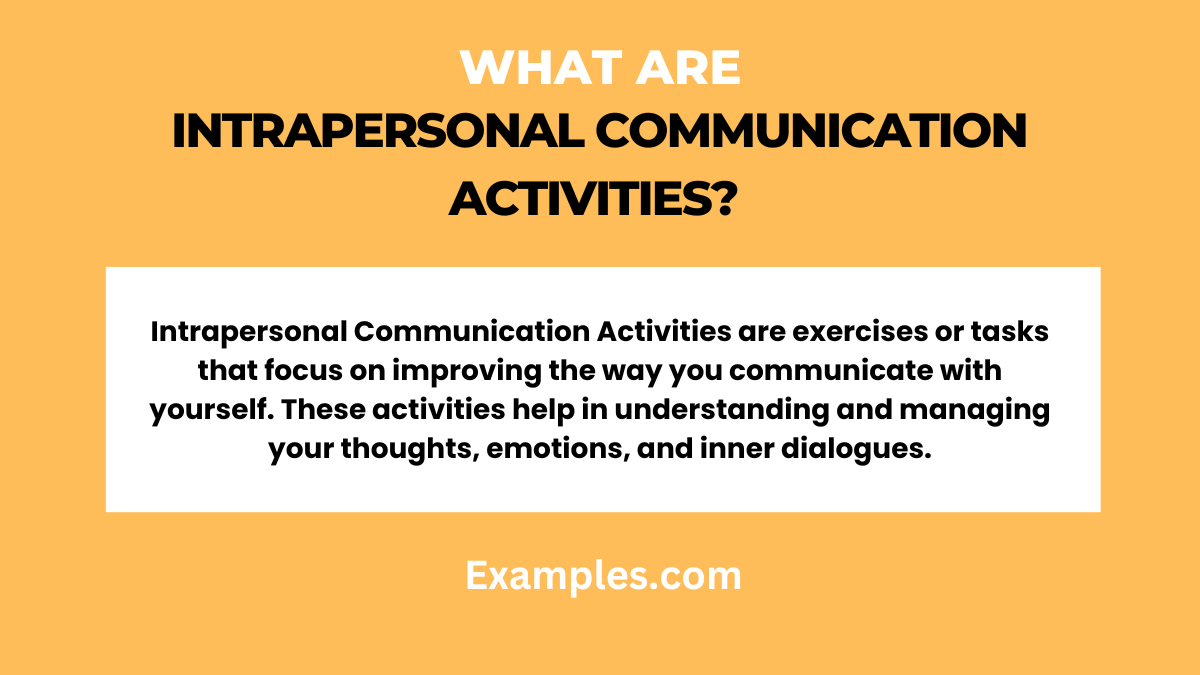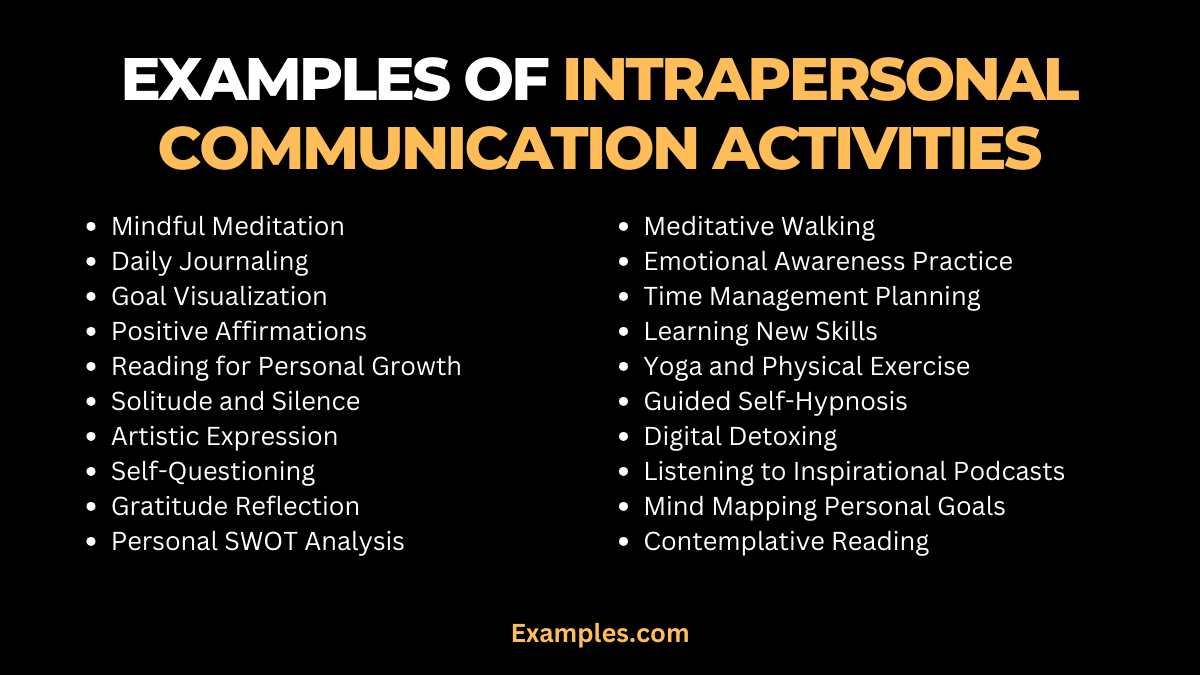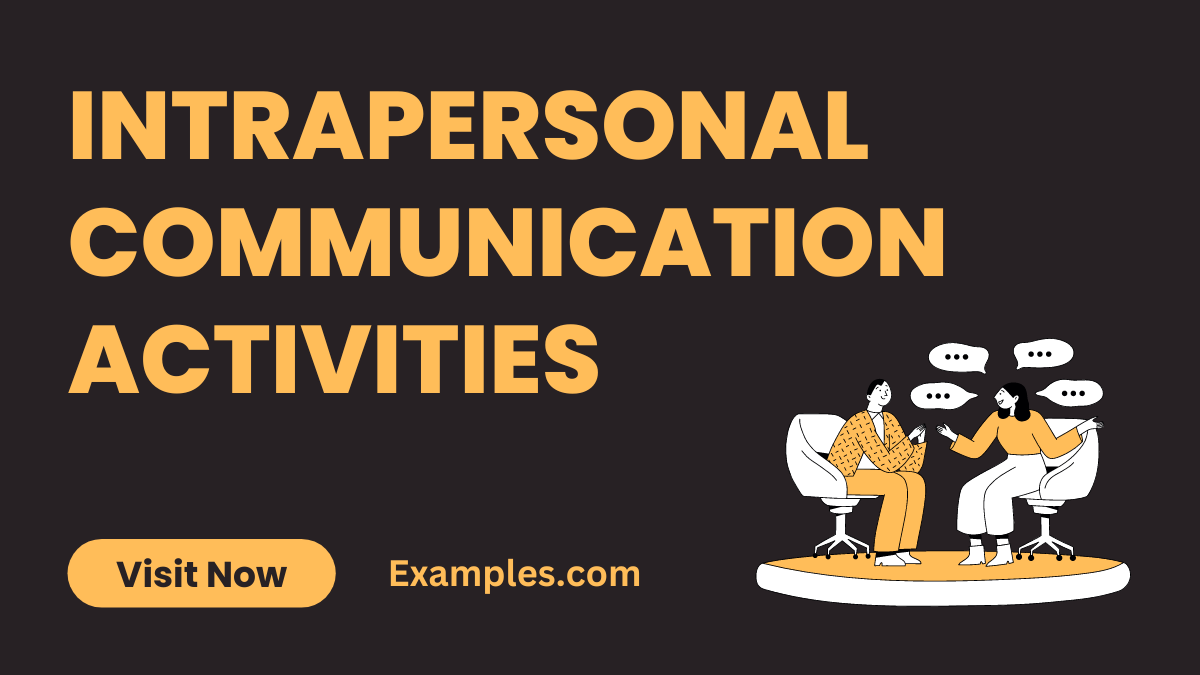19+ Intrapersonal Communication Activities Examples
Dive into our complete guide on Intrapersonal Communication Activities, designed to strengthen your inner dialogue. Packed with practical Intrapersonal Communication Examples, this guide offers a range of activities for enhancing self-awareness, emotional intelligence, and personal growth. Whether you’re a teacher, student, or an adult seeking self-improvement, these activities are tailored to help you explore and improve the most important conversation of all – the one with yourself.
What are Intrapersonal Communication Activities?

Intrapersonal Communication Activities are exercises or tasks that focus on improving the way you communicate with yourself. These activities help in understanding and managing your thoughts, emotions, and inner dialogues. They are essential for boosting self-awareness and enhancing intrapersonal communication skills. Such activities might include journaling, meditation, or goal setting, all designed to strengthen your inner voice and help you reflect on your personal experiences and beliefs. Engaging in these activities regularly can lead to better self-understanding and improved emotional intelligence.
20 Examples of Intrapersonal Communication Activities

Intrapersonal Communication Activities are essential exercises that focus on enhancing self-dialogue and personal understanding. These activities, ranging from reflective practices to creative expressions, are designed to improve self-awareness, emotional regulation, and decision-making skills. Engaging in such activities not only bolsters intrapersonal communication skills but also contributes to overall mental and emotional well-being. This guide provides 20 unique and effective examples, each with a brief explanation and example sentence, demonstrating how to incorporate these activities into daily life.
- Mindful Meditation: Practicing mindfulness through focused breathing or guided imagery.
- Example: Meditating every morning for 10 minutes to center your thoughts.
- Daily Journaling: Writing down your thoughts, feelings, and experiences in a journal.
- Example: Keeping a daily diary to reflect on your day’s events and emotions.
- Goal Visualization: Imagining achieving your personal or professional goals.
- Example: Visualizing yourself succeeding in a job interview or a personal project.
- Positive Affirmations: Repeating positive and empowering statements to yourself.
- Example: Using affirmations like “I am capable and strong” each morning.
- Reading for Personal Growth: Engaging with self-help books that inspire self-improvement.
- Example: Reading a book on emotional intelligence to enhance self-understanding.
- Solitude and Silence: Spending time alone to think and reflect without distractions.
- Example: Setting aside quiet time each day to sit in silence and introspect.
- Artistic Expression: Using art forms like painting or writing to express inner thoughts.
- Example: Creating a painting that reflects your current emotional state.
- Self-Questioning: Asking yourself introspective questions to explore your beliefs and feelings.
- Example: Contemplating questions like “What truly makes me happy?”
- Gratitude Reflection: Regularly identifying and acknowledging things you are grateful for.
- Example: Writing down three things you are grateful for each night.
- Personal SWOT Analysis: Assessing your strengths, weaknesses, opportunities, and threats.
- Example: Creating a SWOT chart to evaluate your personal and professional life.
- Meditative Walking: Mindfully walking and focusing on each step and breath.
- Example: Taking a quiet walk in nature, focusing on the sensation of walking.
- Emotional Awareness Practice: Regularly checking in with and labeling your emotions.
- Example: Identifying and writing down your emotions at different times of the day.
- Time Management Planning: Organizing and planning your daily or weekly schedule.
- Example: Creating a structured plan for your work and personal time.
- Learning New Skills: Taking up new hobbies or courses for personal development.
- Example: Enrolling in a cooking class to learn a new culinary skill.
- Yoga and Physical Exercise: Engaging in physical activities that also focus on mental well-being.
- Example: Practicing yoga to enhance the mind-body connection.
- Guided Self-Hypnosis: Using self-hypnosis techniques for relaxation and self-improvement.
- Example: Listening to a self-hypnosis audio track for stress relief.
- Digital Detoxing: Taking scheduled breaks from digital devices to reduce distraction.
- Example: Allocating weekends as digital-free days for personal time.
- Listening to Inspirational Podcasts: Choosing podcasts that motivate and encourage self-reflection.
- Example: Regularly listening to a podcast on personal growth strategies.
- Mind Mapping Personal Goals: Visually organizing your goals and the steps to achieve them.
- Example: Creating a mind map to outline your career aspirations.
- Contemplative Reading: Engaging with literature that encourages deep thinking and internal dialogue.
- Example: Reading philosophical texts to ponder on life’s big questions.
Intrapersonal Communication Activities for Teachers

For educators, mastering intrapersonal communication is crucial not only for personal development but also for enhancing their teaching effectiveness and classroom dynamics. This guide, optimized for “How to Improve Intrapersonal Communication,” focuses on activities that teachers can incorporate to strengthen their self-dialogue and teaching methodologies.
Reflective Teaching Practice
Reflective teaching is a key intrapersonal communication activity. Teachers can critically evaluate their teaching methods, classroom interactions, and student responses. This reflective practice aligns with various intrapersonal communication theories, enhancing teaching skills and self-awareness.
Educational Journaling
Journaling about teaching experiences is a powerful tool for educators. It allows them to process classroom events, student progress, and personal teaching experiences. This method not only improves intrapersonal communication skills but also aids in developing more effective teaching strategies.
Setting Professional Development Goals
Goal setting is vital for teachers’ professional growth. Setting specific, measurable, achievable, relevant, and time-bound (SMART) goals can guide teachers in improving their intrapersonal communication, classroom management, and instructional techniques.
Mindfulness and Stress Management
Engaging in mindfulness practices helps teachers manage stress and maintain emotional balance. Techniques such as mindful breathing or meditation are crucial for maintaining a clear and focused mind, essential in the demanding teaching environment.
Engaging in Peer Feedback
Peer feedback sessions are invaluable for teachers. Constructive feedback from colleagues, when reflected upon, can lead to improvements in teaching methods and personal growth, highlighting the importance of intrapersonal communication in professional development.
Personal SWOT Analysis for Teaching
Conducting a SWOT analysis focused on teaching can help teachers identify their teaching strengths, areas for improvement, opportunities for professional development, and potential challenges in their educational approach.
Professional Reading and Research
Staying informed with the latest educational research and theories can provide teachers with new insights into effective teaching and intrapersonal communication. This continuous learning is crucial for adapting to evolving educational trends and student needs.
Attending Workshops and Seminars
Teachers can benefit significantly from attending professional development workshops and seminars. These events offer new teaching strategies and insights into effective intrapersonal communication, enhancing their educational practices.
Creative Teaching Methods
Implementing creative teaching methods requires reflective thinking and adaptability. Teachers can explore various teaching styles and techniques, such as incorporating arts or technology in the classroom, to engage students more effectively.
Self-Compassion and Positive Affirmations
Practicing self-compassion and using positive affirmations are important for teachers to maintain a positive self-view and resilience. Acknowledging personal effort and celebrating small successes can significantly boost morale and self-confidence.
Intrapersonal Communication Activities for Students

Students of all ages can benefit immensely from engaging in intrapersonal communication activities. These practices not only enhance their intrapersonal communication skills but also contribute to their academic and personal development. The following activities are tailored to help students improve their self-dialogue, fostering better self-understanding and emotional intelligence, crucial for their growth and learning.
Daily Goal Setting
Encouraging students to set daily academic and personal goals helps them develop focus and direction. This practice aligns with Maslow’s Hierarchy of Needs, emphasizing the importance of self-fulfillment in motivation.
Reflective Journaling
Journaling provides students with an outlet to express their thoughts and feelings. Reflecting on their day or academic experiences helps in processing emotions and enhancing self-awareness.
Mindfulness Practices
Mindfulness activities, such as focused breathing or guided meditation, aid students in managing stress and improving concentration, essential for academic success and intrapersonal communication in school settings.
Affirmation and Positive Self-Talk
Teaching students to engage in positive self-talk and affirmations can boost their self-esteem and resilience, especially in facing academic challenges and personal hurdles.
Creative Expression
Creative activities like art, writing, or music offer students a channel to explore and express their inner thoughts and emotions, enhancing their intrapersonal understanding.
Peer Discussion Groups
Participating in discussion groups where students share and reflect on personal experiences can help them gain different perspectives and improve their intrapersonal dialogue.
Time Management Exercises
Time management is crucial for students. Engaging in planning and organizing their study and leisure time helps in developing self-discipline and effective intrapersonal communication.
Self-Assessment Quizzes
Self-assessment quizzes enable students to evaluate their understanding and learning, fostering a habit of self-reflection and continuous improvement.
Reading and Contemplation
Encouraging students to read books that prompt introspection and then reflect on the themes and lessons learned can enhance their intrapersonal communication and critical thinking skills.
Stress Management Techniques
Learning stress management techniques such as deep breathing exercises or yoga can help students navigate academic pressures, enhancing their mental well-being and intrapersonal communication.
Intrapersonal Communication Activities for Adults

Intrapersonal communication is equally important for adults, playing a significant role in their personal and professional lives. The following activities are designed to help adults enhance their intrapersonal communication, leading to improved decision-making, better stress management, and greater self-awareness.
Personal Development Workshops
Participating in personal development workshops can provide adults with valuable insights and tools to improve their intrapersonal communication and personal growth.
Career Planning and Goal Setting
Career planning and setting professional goals help adults align their ambitions with their personal values, a crucial aspect of effective intrapersonal communication.
Mindfulness and Meditation
Engaging in mindfulness and meditation can help adults manage stress and improve focus, enhancing their intrapersonal dialogue and emotional regulation.
Self-Reflection Retreats
Attending self-reflection retreats offers adults a chance to disconnect from daily distractions and focus on their personal growth and intrapersonal communication.
Creative Hobbies
Pursuing creative hobbies such as painting, writing, or gardening allows adults to express themselves and explore their inner thoughts and emotions.
Fitness and Wellness Programs
Participating in fitness and wellness programs can enhance the mind-body connection, crucial for effective intrapersonal communication and overall well-being.
Professional Mentoring
Engaging in professional mentoring provides adults with an opportunity to reflect on their career paths and improve their intrapersonal communication related to professional development.
Book Clubs and Discussion Groups
Joining book clubs or discussion groups can stimulate introspection and discussion, enhancing adults’ intrapersonal communication and critical thinking skills.
Balanced Lifestyle Planning
Developing a balanced lifestyle plan, including work, family, and personal time, can help adults manage their life roles more effectively, improving their intrapersonal communication.
Stress Management Workshops
Stress management workshops equip adults with strategies to handle life’s pressures, crucial for maintaining a healthy internal dialogue and emotional well-being.
In conclusion, intrapersonal communication activities play a vital role in enhancing self-awareness, emotional intelligence, and personal growth for individuals of all ages. Whether for students, teachers, or adults, this guide offers practical and insightful strategies to improve internal dialogue. Embracing these activities can lead to more effective self-communication, better decision-making, and a more fulfilling life journey.



